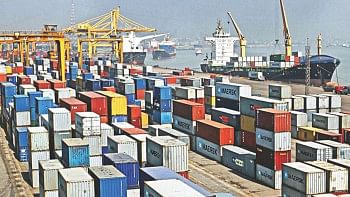US trade gap falls first time in 6 years, China gap hits record
The US trade deficit narrowed in 2007 for the first time in six years, as rising exports supported by a weak dollar helped offset a record gap with China, data showed Thursday.
The trade gap fell to 711.6 billion dollars from 758.5 billion in 2006, the Commerce Department reported.
Blighting the improved trade picture was a persistently high deficit with China, which once again sparked outrage over Beijing's alleged currency manipulation and the loss of US manufacturing jobs.
Last year's 6.2 percent decline in the deficit followed five consecutive years of record peaks and was caused mainly by feeble US economic growth and a declining dollar that blunted demand for imports.
It marked the biggest reduction in the trade deficit since 1991, when the US economy also was slowing, and narrowed the trade gap to 5.1 percent of gross domestic product (GDP) in 2007 from 5.7 percent in 2006.
Exports of US goods and services shot up 12.2 percent from 2006 to 1.62 trillion dollars, while imports climbed a more modest 5.9 percent to 2.33 trillion dollars.
"The rise in exports indicates that foreign demand for US goods remains robust, while import weakness reflects soft US domestic demand and the lower value of the US dollar," said Peter Kretzmer, senior economist at Bank of America.
Economists expect that sluggishness in the US economy, mired in the worst housing slump in several decades and a credit crunch, will drag down global growth, thus reducing demand for US exports despite the dollar's weakness.
"US domestic demand is weakening further but activity was boosted by global demand. How long that will last for is the question," said Andrew Busch, an analyst at BMO Capital Markets.
Relief on the trade front allayed some recession fears. The government has taken a series of monetary and fiscal steps since the subprime, or high-risk, mortgage crisis flared in August, to boost GDP growth that slowed to a 0.6 percent crawl in the fourth quarter.
The Federal Reserve has slashed interest rates and on Wednesday President George W. Bush signed a 168 billion-dollar stimulus package to ward off recession.
"The narrowing of the US trade deficit is providing a valuable offset to the US's slower rate of domestic spending, thereby helps to keep the US out of a recession," John Lonski, chief economist at Moody's Investors Service, told AFP.
But critics pointed to the ballooning trade deficit with China, which jumped 10.2 percent last year to a record 256.3 billion dollars as Americans snatched up cheap Chinese-made goods. They claim China is keeping its yuan currency undervalued to maintain an illegal trade advantage.

 For all latest news, follow The Daily Star's Google News channel.
For all latest news, follow The Daily Star's Google News channel. 



Comments